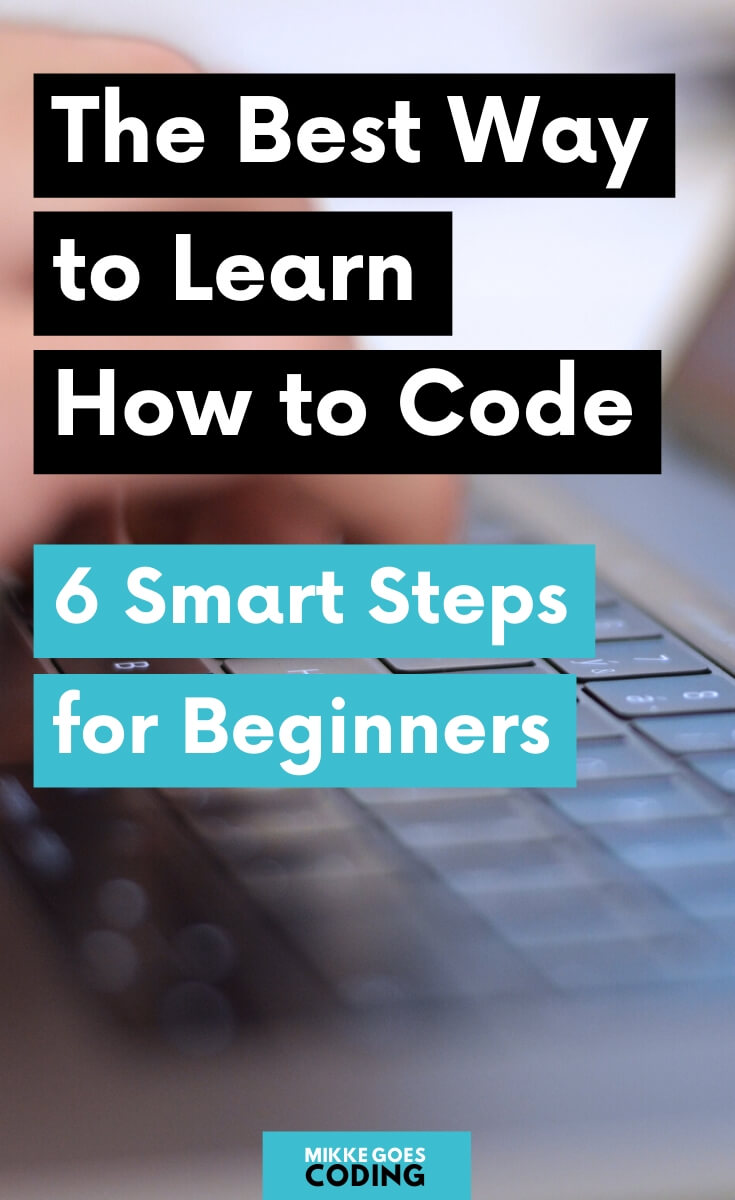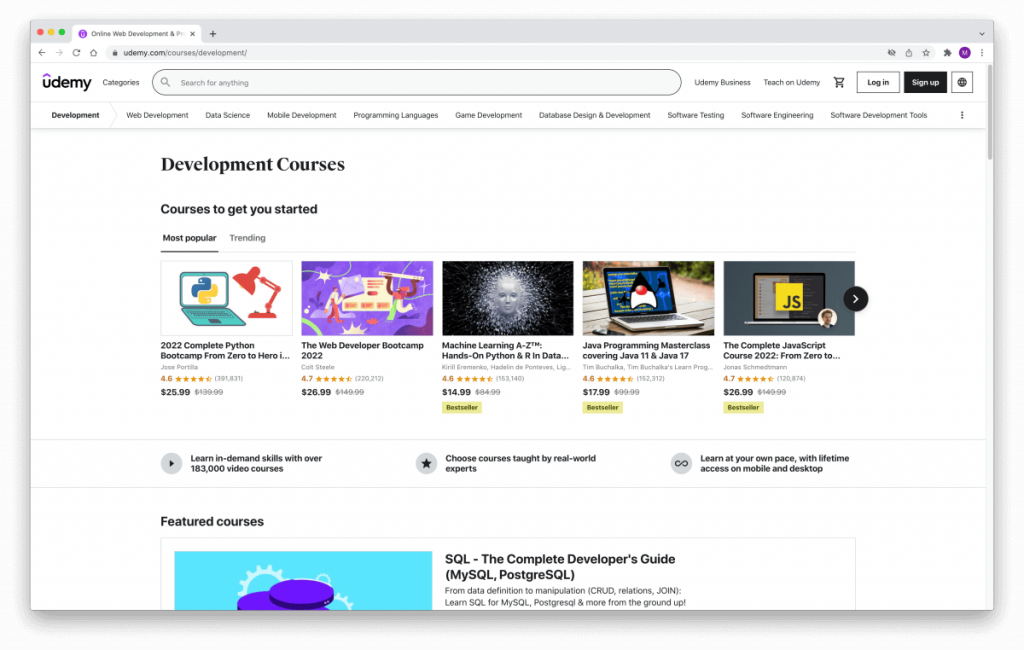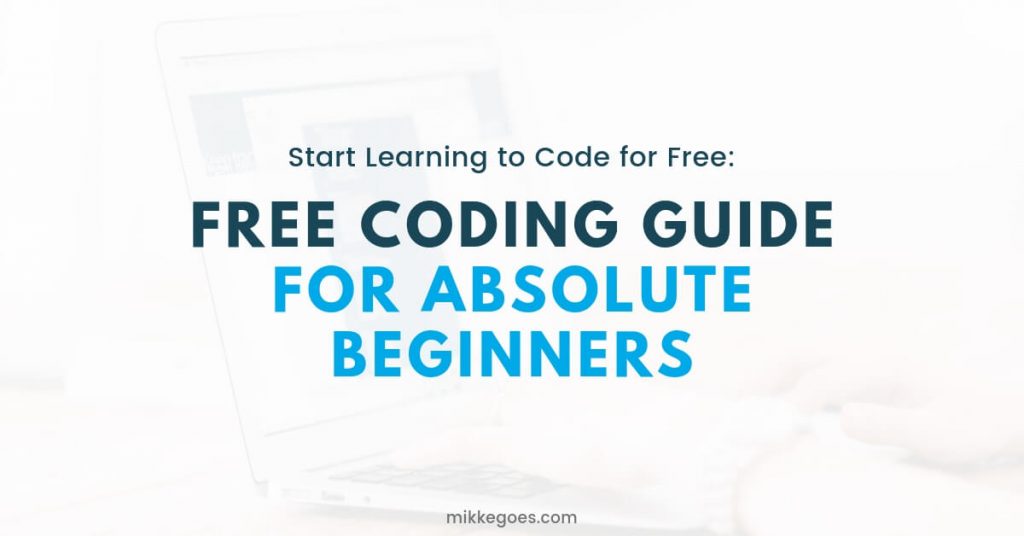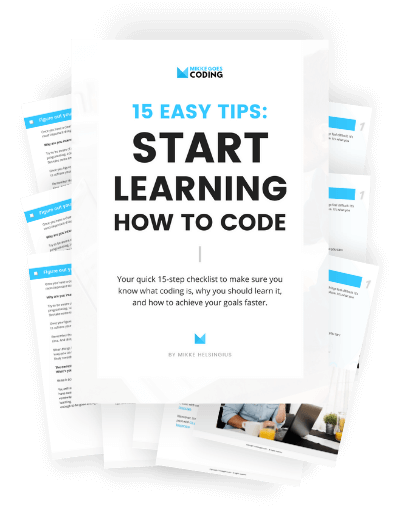I think you will agree with me on one thing: learning to code is really difficult!
So, what is the best way to learn coding from scratch?
When you’re a beginner, how do you know where to start? How can you avoid wasting your time on learning skills you won’t need?
And more importantly, how can you make sure you’re not wasting money on the wrong learning resources?
When I started teaching myself to code in 2016, I wasted several months on the wrong stuff. I knew absolutely nothing about coding, so I jumped into learning a programming language everyone was talking about.
But after a couple of weeks, I started feeling overwhelmed. I didn’t know what I wanted to do with these new skills in the long run.
Luckily, I discovered a few simple learning strategies that helped me get back on track.
Once I knew what I wanted to build and create with my skills, I felt motivated and focused. I knew what I was doing, and mapped out a learning path that would help me achieve my goals as quickly as possible.
After a few short weeks, I started pursuing a freelance web developer career to achieve more financial freedom and to be my own boss. Hands-down the best decision I ever made.
If you are new to coding or you feel overwhelmed right now, you are in the right place.
In today’s post, I’m going to walk you through 6 practical steps to help you teach yourself to code faster.
This simple approach will help you figure out what to learn, why to learn it, and how to go about it so that you will see real progress and results faster.
Here are a few related articles you may want to read, too:
- 120+ Best Free Coding Courses for Beginners
- Why Learn Coding? 12 Essential Benefits From Learning Programming
- 10 Common Coding Myths You Should Ignore
Please note: This post contains affiliate links to products I use and recommend. I may receive a small commission if you purchase through one of my links, at no additional cost to you. Thank you for your support!
The best way to learn to code: 6 smart steps
If you want to start learning to code to become a full-time developer or start freelancing, you want to follow a clear plan to achieve your goals as fast as possible.
To help you plan a clear, step-by-step learning path, here are 6 practical steps you can follow to get closer to your goals without wasting time on skills you don’t need:
- Know your goals
- Understand what coding is
- Choose your specialization
- Start an online coding course
- Solve real-world problems with code
- Build meaningful portfolio projects
Let’s take a closer look at each of these.

Step 1: Know your goals
Let’s start with the very basics. If you want to teach yourself to code, the first thing you need is a clear goal.
I mean, if you don’t have a goal, how could you ever achieve it?
Setting a clear goal is something most beginners tend to neglect.
They start learning one programming language and feel happy when they see some progress.
But before long, they start feeling confused. They lose their motivation and quit altogether.
Why?
Because they don’t know how far they’ve come.
Without knowing a goal and setting clear milestones, you can’t track your progress.
And when you can’t tell if you’re making progress, how could you maintain your motivation?
Therefore, take a few moments to figure out what you want to do with coding. Why do you want to learn how to code?
Your goal might be financial freedom, spending more time with your family, or starting your own business in the future.
Whatever your goals are, just be mindful of them.
Once you know what you want to achieve, it’s so much easier to find a way to get there. You’ll always know how far you’ve come and what you need to do next to get one step closer to your goal.
Read more in my guide on how to start learning to code (the smart way).
Step 2: Understand what coding is
This might sound like a no-brainer, I know. But you don’t want to neglect this point.
I see lots of beginners who jump right into their first online course and start learning. They go through a few lessons and make nice progress. So far so good.
But as the lessons get more demanding, they soon feel lost and confused.
You see, most online coding courses have a very subtle learning curve in the beginning.
But as with anything new we learn, that curve soon becomes pretty steep. That’s when you start feeling overwhelmed because you need to invest more time and effort in making progress.
The only way to prepare yourself is to learn the basic theory of what programming and web development are all about.
I don’t mean you should spend several months learning computer science. But learn at least the basics.
When I started learning to code, I had zero knowledge of how computers work. I didn’t even know how websites work under the hood.
No wonder I felt confused!
But things got much easier once I learned computer science fundamentals. It was the best decision I could have made because it helped me understand the bigger picture of what my code is doing, and how everything is connected.
To help you get started, I created my free coding guide for beginners. It covers the most fundamental topics of what coding is about:
- What is coding?
- Introduction to programming languages
- Front-end vs back-end development
- How the Internet works
- Helpful workflow tools for coding
- Computer science fundamentals
If you’re taking an online course and the topics suddenly feel difficult and too demanding, just take a step back. Go through the chapters one by one and let me know how I can improve them to help you even more!
Step 3: Choose your area of specialization
This is the final step you should take before you start learning how to code in a specific programming language.
If you want to start a career in tech, you need to learn the right tools for the specialization you are interested in.
Because the thing is:
Each programming language is simply a means to an end.
Hence, you’re not learning a particular language just for the sake of it.
Instead, that language is a tool that allows you to build something useful and valuable from scratch.
Just think of carpenters, for example. They don’t learn “the hammer” per se. That’s a tool, not a skill.
So instead, they need to learn how to use a hammer to build beautiful furniture.
Just like a carpenter, you need to learn how to use your tools for real-life projects, such as:
- Building a website
- Programming a video game
- Analyzing data
- Creating machine learning algorithms
- Coding mobile apps for iPhones or Android devices
All of these specializations use different programming languages.
Therefore, you should be mindful of what type of projects you are interested in. Otherwise you could waste weeks, months, or even years learning the wrong tools.
If you are interested in becoming a mobile app developer, you don’t want to learn tools used for data science, for example.
Similarly, if you want to become a web developer, you shouldn’t learn mobile development languages.
Makes sense, right?
If you are new to coding, I know you may not have a clear idea of what you want to do in the future.
To help you compare your options, I put together this guide for choosing your first programming language.
Step 4: Start an online coding course
Alright, it’s time to pull out the big guns!
Now that you know why you want to learn coding and what you want to specialize in, you’re ready to start learning.
The most difficult part of starting out is to find the best resources for beginners. You can choose between online courses and books or find a beginner-level tutorial online.
But with hundreds of courses and tutorials out there, most newbies just feel overwhelmed and confused at this point.
I remember spending hours and days looking for my first coding course. I ended up paying a big buck for a course that was just rubbish, wasting both my money and my time.
My suggestion is that you start by using free resources. Give coding a try and see if it’s your thing.
Use these best free websites to learn to code for free.
If it’s a good fit, consider investing a few bucks in a premium course. They usually include more realistic projects you can add to your portfolio. By the time you finish your course, you will have a nice selection of real-life projects to showcase your skills.
I found the best coding courses on Udemy when I first started learning how to code.
The first course I took was The Complete Web Developer Course 2.0, which paid itself back in just a few weeks: After learning and practising my HTML and CSS, I got my first small freelance gig online. Money well spent!

Step 5: Solve real-world problems
Coding is all about solving problems, right?
And if you want to become a professional developer, solving problems will pay your bills in the future.
Thus, the best way to land a developer job is to show how well you can solve problems for your potential employer. And hey, practice makes perfect, right?
Therefore, while you’re going through your online course, take a breaks from your lectures as often as you can. Work on small projects of your own without following video tutorials.
For example, here are a few ideas to apply your skills to real-life problems:
- Create a small program to sort your emails
- Update a website of a friend or relative
- Automate a daily report at work
- Write a program that organizes your photos
- Build a small Twitter bot program
Depending on what your first coding course is about, you can come up with much better ideas than I can.
You shouldn’t have any problems finding ideas for small projects if you followed the steps in this article.
When you’re learning tools you want to use in the future, you should already have a few project ideas in your head.
Recommended: 10 Simple Tips to Learn Coding More Efficiently
Step 6: Build meaningful projects
Ok, I saved the best for last!
When you apply for developer jobs in the future, your employers are NOT interested in what skills you know per se.
Instead, they want to see what you can create and build with those skills.
Unless you have a solid portfolio to show what you’re capable of, forget about applying for the job.
But if you hit them with an amazing selection of practical projects you’ve finished, you’re much more likely to get a callback.
If you’re not sure where to start, read these smart tips on how to find the best coding projects.
So, how do you know what type of projects to build? What does your employer want to see?
First of all, you need a portfolio website. You can build one from scratch if you’ve learned HTML and CSS.
However, I’d recommend using WordPress. Knowing how to use WordPress is just another skill to add in your CV. If you’re not familiar, check out my post on why you should use WordPress for your web projects.
In the beginning, upload even the smallest projects into your portfolio. Don’t forget to mention how carefully you planned and managed the project. And if it was for someone else, remember to emphasize your communication and coordination skills, too.
As your skills improve, you’ll be able to build bigger, more demanding projects.
The most important thing to keep in mind is to know what your dream employer wants. Here are three steps you should take asap:
- Browse through a few job descriptions from companies you’d like to work at.
- See what skills they are looking for.
- Make sure you use those skills in your portfolio projects.
That job will be yours for the taking!
Read next:
- Easy JavaScript Projects You Can Build to Perfect Your Coding Skills
- Python Projects for Beginners: 10 Fun Python Programming Project Ideas
Remember: Find learning methods that work for you
I hope you’re still with me! Did you find a few helpful tips above? Drop me a line in the comments section!
When you start learning how to code, remember to take it slow. You can follow the steps above to find the best way to learn coding that works for your.
I know it’s a lot to take in if you’re just starting out. But trust me, these steps work.
If you have a solid plan and you know what you want to achieve, you’re already halfway there. Don’t let your goals get out of your sight. You will achieve them.
Sure, you won’t become a developer overnight, and you will go through a few rough patches.
But when you have a goal and know what you should do next to achieve it, things will be much easier.
Also, keep in mind that we all have our own ways of learning new things. Even though we all want to learn how to code, our journeys are very different.
Therefore, remember this: What works for someone else doesn’t have to be the best way to learn coding for you.
That said, don’t be afraid to try different learning methods and resources. It’s all about patience and finding the optimal learning recipe that you feel comfortable with.
Recommended: Learning Programming: Online Courses vs Coding Books
Final thoughts: The best way to learn to code
Learning how to code doesn’t have to be difficult.
Even if you’re a total beginner, you can learn coding from scratch easily with the helpful strategies in this article.
When you want to find the best way to learn coding, you need to start with a robust plan. Let’s recap:
- First, think about why you want to learn coding from scratch.
- Then, understand the basics of programming and computers.
- Next, you should pick an area to specialize in. Websites? Mobiles apps? Games? Data science?
- Start your first coding course. It’s much easier to stay focused and motivated when you’re prepared for what you’ll learn.
- Throughout your coding course, apply what you learn to real-life projects. Use code to solve small problems for yourself or for someone you know.
- As your skills improve, move onto bigger projects. Upload them into your portfolio one by one. Then rinse and repeat!
Are you ready to start? I know you’ll nail it!
Whenever you feel ready, here are a few helpful articles to get you started:
- The Best Websites to Learn Coding
- 8 Critical Things to Know Before Learning Programming
- How to Become a Web Developer? FAQ: Careers, Salaries, and Skills
If you enjoyed this post on the best way to learn coding, just drop me a line in the comments below!
Happy learning!
– Mikke




Hi I am interested in coding and this your beginner tips was really helpful I really appreciate it so I just finished reading and I will be visiting each site under the blue ticks….. Thank you so much